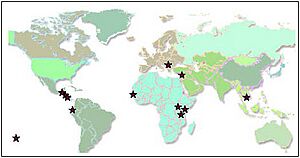Kiva (organization) facts for kids
 |
|
| Founded | October 2005 |
|---|---|
| Founders |
|
| Focus | Economic development |
| Location |
|
|
Area served
|
World-wide |
| Method | Microcredit |
|
Key people
|
Chris Tsakalakis (CEO) |
|
Revenue (2023)
|
$34,727,565 |
| Expenses (2023) | $37,635,582 |
| Endowment | $27,389,839 |
|
Staff (2023)
|
170 |
|
Volunteers (2015)
|
450 |
Kiva Microfunds is a special kind of non-profit organization based in San Francisco, California. Its main goal is to help people around the world get access to money so they can improve their lives and communities. Kiva does this by expanding "financial access" for communities that don't have many banking options.
Kiva doesn't usually give money directly to individuals. Instead, it works with other groups like microfinance institutions, social businesses, schools, or non-profit organizations. These partners then give out the loans to people who need them. Kiva gets its money from grants, loans, and donations from people like you, companies, and big organizations.
Since it started in 2005, Kiva has helped fund over 1.6 million loans. This adds up to more than $1.68 billion! A great thing is that about 96.3 percent of these loans are paid back. More than 2 million lenders from all over the world use Kiva to help others.
Contents
How Kiva Started
Kiva was created in October 2005 by Matt Flannery and Jessica Jackley. They got the idea for Kiva after hearing a talk by Muhammad Yunus, who started the Grameen Bank. He spoke about "microfinance," which means giving very small loans to people who are poor to help them start businesses.
Jessica Jackley later worked with a group that helped small businesses in East Africa. When Matt Flannery visited her, they talked to many entrepreneurs. They found that a big problem for these people was not having enough money to start their businesses. After returning home, Matt and Jessica started planning Kiva. The name "Kiva" means "unity" in the Swahili language.
In April 2005, Kiva funded its first seven loans. These loans totaled $3,500 and went to a group of entrepreneurs who were called the "Dream Team."
How Lending Works
Kiva works with over 300 "Field Partners" around the world. These partners are microfinance groups, social businesses, schools, or non-profit organizations. They post stories of local entrepreneurs who need loans on the Kiva website.
People who want to help, called "lenders," can look at these stories on kiva.org. They choose an entrepreneur they want to support. Lenders can loan money in amounts as small as $25. Kiva collects the money from many individual lenders. Then, it sends the total loan amount to the right Field Partner. The Field Partner then gives the loan to the entrepreneur.
Kiva itself does not charge interest on the money it sends to its partners. However, the Field Partners often charge a small amount of interest to the borrowers. This helps them cover their costs for managing all the tiny loans. When the entrepreneurs pay back their loans, the Field Partners send the money back to Kiva. Once the loan is repaid, Kiva lenders can either take their money back or lend it again to another entrepreneur.
Kiva's Money Matters
As of March 2016, Kiva had helped distribute over $827 million in loans. These loans came from nearly 1.4 million lenders and went to almost 2 million borrowers. The average loan size was about $411. The repayment rate for all Kiva's partners was 97.1%.
Kiva gets its main funding from grants, financial support, and special deals from big companies and organizations. For example, Chevron Corporation, Visa Inc., and Skoll Foundation have given Kiva large grants. Kiva also won grants from Sam's Club and American Express. The Omidyar Network gave Kiva a $5 million grant to help it grow its partnerships.
What Kiva Loans Are Used For
Supporting Women in Business
Kiva is very focused on helping women. As of October 2017, about 81% of Kiva's loans had gone to women. Helping women get loans can make a big difference in their lives and communities. It can also help protect them and improve their standing in society.
Green Loans for a Better Planet
In 2011, Kiva started offering "green loans." These loans help people get cleaner and safer energy. They also support sustainable farming, better transportation, and recycling. Green Kiva loans can help fund things like solar panels, organic fertilizers, and efficient cooking stoves. By December 2013, Kiva lenders had funded 4,600 green loans.
Helping Students Go to College
Kiva also has a Student Microloans program, which started in 2010. This program helps students get loans to go to college or other higher education programs. Students usually have 1 to 3 years to pay back these loans. In 2014, Kiva worked more closely with an organization called Vittana. Vittana helps low-income students in Asia, Africa, and Latin America get loans for their education. Now, many of the loans Vittana finds are also available for funding on Kiva.
Medical Loans for Health
Some of Kiva's partners specialize in giving loans for medical needs. These loans can help people pay for healthcare. Experts have suggested that these small medical loans can be a good way to help people in developing countries get the medical care they need.
Supporting Refugees
In July 2017, Kiva launched a World Refugee Fund. This fund helps refugees and the communities that host them in countries like Lebanon, Jordan, and Turkey. As refugees pay back their loans, they build a financial history in their new homes. This can help them get more support in the future.
Other Kiva Programs
Kiva U.S.
In 2011, Kiva started Kiva U.S. This program offers 0% interest loans to entrepreneurs in the United States. These loans are often for people who couldn't get loans from regular banks. Kiva U.S. uses "trustees" – like local non-profits or community leaders – who support the borrowers. The average loan size for U.S. borrowers is $5,000, and they usually have about two years to pay them back.
Kiva Labs
Google gave Kiva a $3 million award in 2013 for its Kiva Labs project. Kiva Labs looks for new ways to make microfinance even better. This includes trying out lower interest rates, more flexible payment plans for farmers, and longer-term loans for things like education. Kiva Labs also works on getting clean energy technology to more people and using mobile phones to share knowledge.
Kiva City
Kiva City helps local business owners and entrepreneurs in U.S. cities get loans through crowdfunding. This program was launched in 2011 by Kiva and former U.S. President Bill Clinton. Kiva City programs are in many cities, including Detroit, New Orleans, Los Angeles, and New York City. For example, in less than a year, the Kiva City program in Richmond, Virginia, helped fund over $100,000 in loans for local businesses.
How Kiva Gets the Word Out
In March 2012, Reid Hoffman, who co-founded LinkedIn, loaned Kiva $1 million. Kiva then let 40,000 people lend $25 for "free." This meant the borrowers would pay back Reid Hoffman instead of the person who chose them. Kiva hoped this would encourage more people to try lending and become regular users.
Bill Clinton also wrote about Kiva.org in his 2007 book, Giving: How Each of Us Can Change the World. He highlighted the important work Kiva was doing.
What Others Say About Kiva
Many independent groups have reviewed Kiva:
- Charity Navigator, a group that rates charities, has often given Kiva a top rating of 4 stars since 2010.
- In 2013, Google.org gave Kiva a $3 million award for Kiva Labs after a detailed review.
- In 2012, Philanthropedia gave Kiva its Top Non-Profit Award.
- The Economist magazine honored Kiva with its Innovation Award in 2011.
- In 2010, the Omidyar Network gave Kiva a $5 million grant to help it grow.
- Kiva was also chosen as one of Oprah's Ultimate Favorite Things in 2010.
- In 2009, GiveWell reviewed Kiva and other similar lending sites. It suggested that while Kiva is big, it was hard to see if it made a huge social difference at that time.
- TIME magazine named Kiva a Top 50 website in 2008.
- In 2007, Skoll Foundation gave Kiva a $1 million grant, recognizing it as one of the best social enterprises.
Images for kids
See also
 In Spanish: Kiva (organización) para niños
In Spanish: Kiva (organización) para niños
- Microcredit
- Social entrepreneurship
- Vittana
External Links
- TED: Jessica Jackley: Poverty, money -- and love
ca:Kiva



